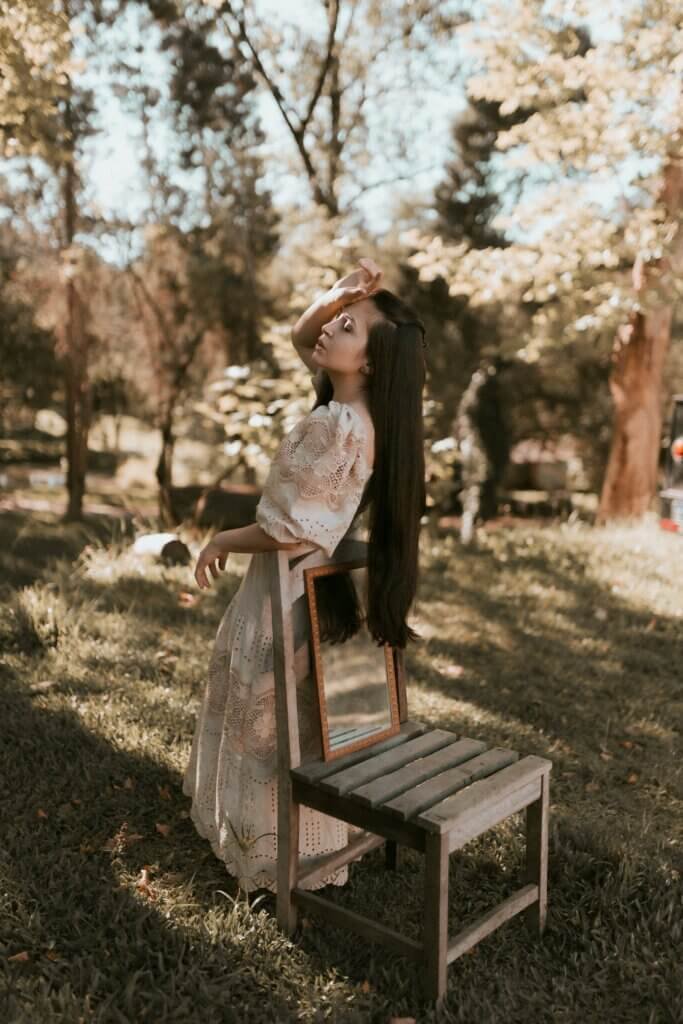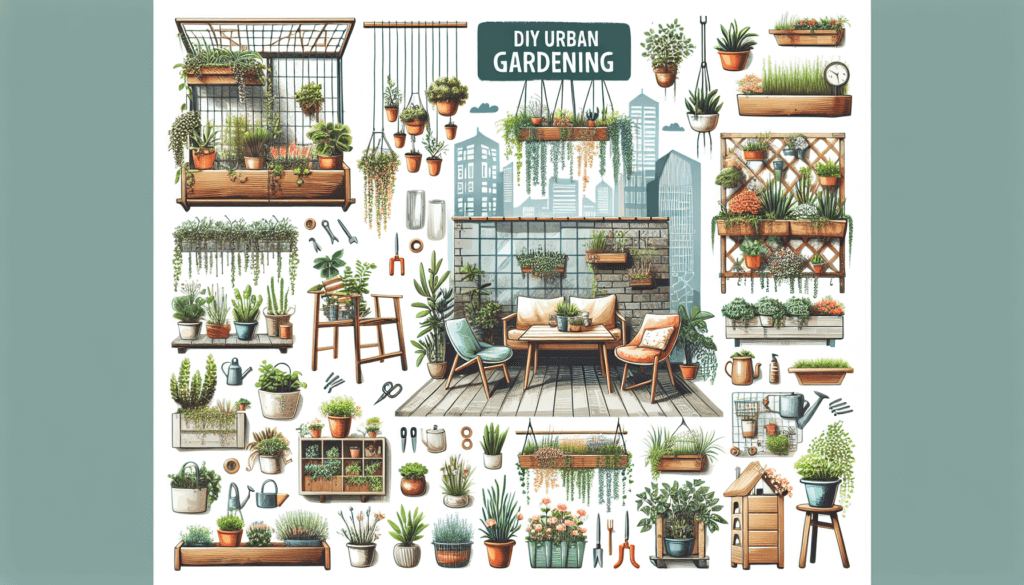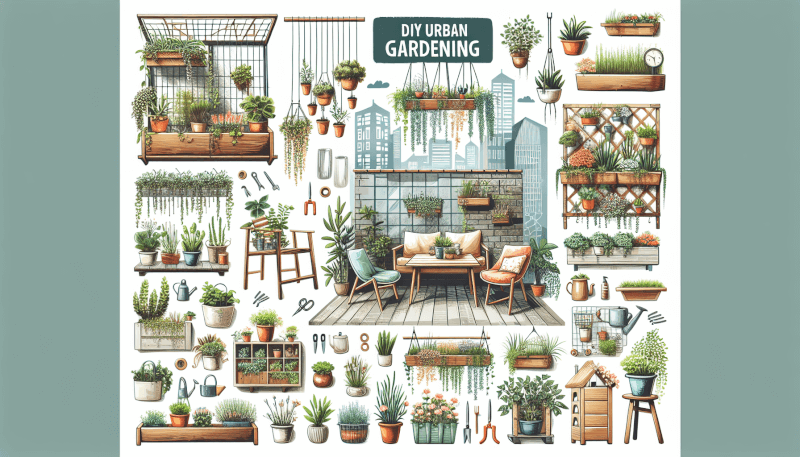So, you’ve got the desire to start your own urban garden, but you’re on a tight budget. Don’t worry, because we’ve got you covered! In this article, we’ll explore the most popular DIY urban gardening projects that won’t break the bank. Whether you’re living in a small apartment or a tiny backyard, these budget-friendly ideas will help you transform your space into a green oasis. From vertical herb gardens to repurposed containers, you’ll discover creative and affordable ways to cultivate your own urban paradise. Get ready to roll up your sleeves and get planting!

Container Gardening
Container gardening is a great option for those with limited space or who want to add some greenery to their homes. With container gardening, you can grow plants in pots, buckets, or any other suitable container. It’s a versatile and flexible way to create a beautiful garden, no matter how small your living space may be.
Vertical Gardens
One popular trend in container gardening is the concept of vertical gardens. Vertical gardens are a space-saving solution that allows you to grow plants vertically, utilizing walls or other vertical structures. You can create a vertical garden using hanging pots, wall-mounted planters, or even repurposed materials like pallets. Not only do vertical gardens maximize space, but they also add a unique and eye-catching element to your home or outdoor space.
Container Herb Garden
If you love cooking with fresh herbs, a container herb garden is a must-have. With a container herb garden, you can have a variety of herbs at your fingertips, ready to be used in your favorite recipes. All you need is a few pots, some quality soil, and your favorite herb seeds or seedlings. Place the pots in a sunny spot, water regularly, and soon you’ll have a fragrant and delicious herb garden right in your kitchen or patio.
Windowsill Vegetable Garden
For those who crave fresh vegetables but lack garden space, a windowsill vegetable garden is the answer. With just a few pots or containers, you can grow your own veggies right on your windowsill. Choose compact and fast-growing vegetables like lettuce, spinach, or cherry tomatoes. Place the pots near a sunny window, water regularly, and enjoy the satisfaction of harvesting your own homegrown vegetables.
Indoor Gardening
If you want to bring the beauty of nature indoors, indoor gardening is the way to go. Whether you have a green thumb or are just starting to explore the world of plants, indoor gardening offers endless opportunities to nurture and grow a variety of plants.
Terrarium
Creating a terrarium is a fun and easy way to add a touch of green to your indoor space. A terrarium is a glass container that houses a miniature garden ecosystem. You can choose from a variety of plants, mosses, and even small decorative elements like rocks and figurines. With the right amount of light and moisture, your terrarium will thrive and become a stunning centerpiece in your home.
Hydroponics
Hydroponics is a soilless gardening method that allows you to grow plants in nutrient-rich water instead of traditional soil. This technique is gaining popularity among urban gardeners due to its space-saving nature and efficient use of resources. With a hydroponic system, you can grow a wide range of plants, from leafy greens to herbs and even certain fruits. It’s a fascinating way to grow plants and brings a modern and futuristic touch to your indoor garden.
Indoor Vertical Garden
Just like outdoor vertical gardens, indoor vertical gardens are an excellent option for maximizing space in a small indoor area. You can create a vertical garden using wall-mounted planters or even repurposed materials like pallets. Having an indoor vertical garden not only adds a unique and beautiful element to your home but also provides a natural air purifier, improving the air quality and creating a healthier environment.

Recycled Container Gardening
If you’re passionate about sustainability and recycling, why not incorporate that into your container gardening? Recycled container gardening allows you to give a new life to items that would otherwise end up in the landfill. It’s a cost-effective and eco-friendly way to create a unique and personalized garden.
Tire Planters
Old tires can be repurposed into unique and eye-catching planters. By painting and stacking them, you can create a tiered planter that can house a variety of plants. Tire planters not only add a touch of creativity to your garden but also provide a durable and long-lasting solution for your plants.
Plastic Bottle Planters
Plastic bottles are another item that can be easily transformed into functional planters. By cutting the bottles in half and adding some drainage holes, you can create a budget-friendly and eco-friendly container for your plants. Plastic bottle planters are perfect for small plants or herbs, and you can even hang them to save space.
Pallet Garden
Pallets are versatile and can be repurposed into various garden structures, including planters. By creating vertical or horizontal planters with pallets, you can add a rustic and charming touch to your garden. Pallet gardens are perfect for growing a variety of plants, from vegetables to flowers, and can be easily customized to fit your space and design preferences.
Upcycled Garden Furniture
Why buy new garden furniture when you can repurpose and upcycle materials to create unique and eco-friendly planters? Upcycled garden furniture not only adds a personal touch to your garden but also helps reduce waste and promotes sustainability.
Pallet Planters
Pallets can be transformed into stylish and functional planters. By attaching pots or containers onto the pallets and filling them with soil, you can create a vertical garden or a raised bed planter. Pallet planters are not only practical but also add a rustic and charming look to your outdoor space.
Old Drawer Planters
Repurposing old drawers as planters is an innovative and creative way to add greenery to your garden. By giving old drawers a fresh coat of paint and adding drainage holes, you can create unique and eye-catching planters. Old drawer planters are perfect for small plants or herbs and can be placed on the ground or hung on a wall.
Repurposed Tires as Planters
Just like tire planters mentioned earlier, repurposed tires are a fantastic material for creating planters. By painting the tires and filling them with soil, you can turn them into colorful and durable planters that can withstand the elements. Repurposed tire planters are not only a budget-friendly option but also help reduce waste by giving new life to old tires.

DIY Trellis and Vertical Garden Structures
Trellises and vertical garden structures not only provide support for climbing plants but also add visual interest and height to your garden. Building your own trellis or vertical garden structure allows you to customize it to your space and design preferences.
Bamboo Trellis
Bamboo is a sustainable and versatile material that can be used to create beautiful trellises. By using bamboo canes and some garden twine, you can build a sturdy and natural-looking trellis for your climbing plants. Bamboo trellises add an exotic and tropical touch to your garden and can be easily integrated into any outdoor space.
PVC Pipe Trellis
PVC pipes are a budget-friendly and readily available material for creating trellises. By cutting and joining PVC pipes, you can build a customizable and durable trellis for your plants. PVC pipe trellises are perfect for supporting lightweight and vining plants and can be easily moved or disassembled if needed.
Repurposed Ladder Trellis
If you have an old ladder lying around, don’t let it go to waste! Repurpose it into a trellis for your climbing plants. By leaning the ladder against a wall or fence and attaching wire or twine for the plants to climb, you can create a unique and functional trellis for your garden. Repurposed ladder trellises add a touch of vintage charm and can be easily incorporated into any outdoor space.
Raised Bed Gardening
Raised bed gardening has many advantages, including better soil control, improved drainage, and easier access for gardening activities. With raised beds, you can create a productive and beautiful garden no matter the limitations of your existing soil or space.
Cinder Block Raised Bed
Cinder blocks are a budget-friendly and versatile material for building raised beds. By stacking and arranging the cinder blocks, you can create a durable and customizable raised bed for your plants. Cinder block raised beds are not only easy to build but also provide excellent drainage and can be used in both outdoor and indoor settings.
Wooden Pallet Raised Bed
Wooden pallets can be repurposed into raised beds, providing a rustic and charming look to your garden. By disassembling the pallets and reassembling them into a raised bed structure, you can create a budget-friendly and sustainable garden bed. Wooden pallet raised beds are perfect for growing a variety of plants, from vegetables to flowers, and can be easily customized to fit your space and design preferences.
Straw Bale Raised Bed
Straw bales are an unconventional but effective material for raised beds. By using straw bales as the walls of your raised bed, you can create a natural and sustainable gardening solution. Simply place the straw bales in the desired shape and fill the center with compost or soil. Straw bale raised beds provide excellent insulation and can even act as a composting system as the straw breaks down over time.

Garden Pathways
Garden pathways not only provide a practical purpose but also add beauty and structure to your outdoor space. There are various materials and designs to choose from, allowing you to create a pathway that suits your garden style and personal taste.
Pebble Pathway
A pebble pathway is a simple and cost-effective way to add texture and visual interest to your garden. By laying down a bed of gravel or fine pebbles, you can create a charming and low-maintenance pathway. Pebble pathways are perfect for informal gardens or areas with heavy foot traffic, as they provide excellent drainage and allow water to flow freely.
Stepping Stone Pathway
Stepping stone pathways are a classic and timeless choice for gardens. By placing flat and sturdy stones in a pattern or configuration, you can create a visually appealing and functional pathway. Stepping stone pathways can be personalized with different types of stones, colors, or even mosaic designs to add a unique touch to your garden.
Log Slice Pathway
For a more rustic and natural look, consider using log slices to create a pathway. By cutting logs into flat slices and placing them in a pattern or configuration, you can create an organic and charming pathway. Log slice pathways are perfect for woodland or cottage-style gardens and add a touch of warmth and character to your outdoor space.
Vertical Wall Gardens
Vertical wall gardens are an excellent way to bring greenery to vertical surfaces, such as walls or fences. They not only maximize space but also create a stunning visual display and improve the air quality.
Pallet Wall Garden
Repurposed pallets can be transformed into vertical wall gardens, offering a unique and cost-effective solution for adding plants to your walls. By attaching pots or containers to the pallets and adding soil and plants, you can create a vertical garden that can be easily mounted to any vertical surface. Pallet wall gardens are perfect for both indoor and outdoor spaces, providing a creative and sustainable way to bring nature into your surroundings.
Pocket Planters
Pocket planters are a practical and space-saving option for vertical wall gardens. These specialized planters have pockets or pouches that allow you to grow plants vertically. By attaching the pocket planters to a wall or fence, you can create a lush and vibrant display of plants. Pocket planters are perfect for small and compact plants, such as herbs, succulents, or small flowering plants.
Gutter Gardens
Repurposing old gutters as vertical wall gardens is a clever and eco-friendly way to add greenery to your outdoor space. By attaching the gutters to a wall or fence, you can create a neat and organized garden display. Gutter gardens are perfect for plants with shallow roots, such as lettuces or strawberries, and can be easily customized to fit your available space and design preferences.

Herb Spiral
An herb spiral is a beautiful and functional garden structure that allows you to grow a variety of herbs in a small space. It consists of a spiral-shaped raised bed that creates different microclimates, enabling you to grow herbs with different moisture and light requirements.
Building an Herb Spiral
To build an herb spiral, start by selecting a suitable location in your garden or outdoor space. Clear the area of any grass or weeds and mark the desired size and shape of your spiral. Start with a sturdy base layer of rocks or bricks, creating a stable foundation for your raised bed. Gradually build up the spiral, using a mixture of soil, compost, and gravel. The outer edges of the spiral should be higher than the inner edges to create the different microclimates.
Planting in an Herb Spiral
When it comes to planting in an herb spiral, consider the different moisture and light requirements of the herbs you want to grow. Place herbs that require more water, such as mint or parsley, in the lower and damper sections of the spiral. Herbs that prefer drier conditions, such as rosemary or thyme, can be placed in the upper and drier sections of the spiral. Plant the herbs according to their specific needs, ensuring they have enough space to grow and thrive.
Herb Spiral Care
To ensure the success of your herb spiral, it’s important to provide the proper care and maintenance. Regularly water the herbs, taking into account the different moisture requirements of each herb. Mulching the soil can help retain moisture and prevent weed growth. Harvest the herbs regularly to promote healthy growth, and prune or trim them as needed. Also, monitor for any pests or diseases and take appropriate measures to control them.
Composting
Composting is a sustainable and essential practice for any garden. It allows you to turn organic waste into nutrient-rich compost, providing your plants with the necessary nutrients for healthy growth.
DIY Composting Bin
Building your own composting bin is a simple and cost-effective way to start composting. You can use materials like wood, wire mesh, or even repurposed pallets to construct a sturdy and functional bin. The composting bin should have adequate airflow and drainage to facilitate decomposition. Layer your compostable materials, including kitchen scraps, yard waste, and shredded paper, and regularly turn the pile to speed up the decomposition process. In no time, you’ll have a rich and nutritious compost to feed your plants.
Bokashi Composting
Bokashi composting is an anaerobic composting method that utilizes specialized microorganisms to break down organic waste. It’s a convenient and odor-free alternative to traditional composting, making it ideal for small spaces or indoor composting. Bokashi composting involves fermenting your food scraps using a bran mixture infused with beneficial microorganisms. The fermented waste can then be buried in soil or added to a traditional compost bin to complete the decomposition process.
Vermicomposting
Vermicomposting, also known as worm composting, is a fascinating and efficient way to compost organic waste. It involves the use of specialized composting worms, such as red wigglers, to break down organic matter into nutrient-rich castings. To start vermicomposting, you’ll need a suitable container or bin, bedding materials like shredded newspaper or cardboard, and a colony of composting worms. Add your organic waste to the bin, making sure not to overload the worms, and regularly maintain the bedding moisture and temperature. The worms will do the rest, turning your kitchen scraps into valuable worm castings that can be used as a natural fertilizer for your plants.
In conclusion, DIY urban gardening projects offer endless possibilities for creating beautiful, sustainable, and budget-friendly gardens. Whether you’re limited by space, resources, or design preferences, there is a project to suit your needs. From container gardening and vertical gardens to raised beds and composting, you can bring the joys of gardening to any urban environment. So get creative, embrace your green thumb, and let your urban garden flourish!


